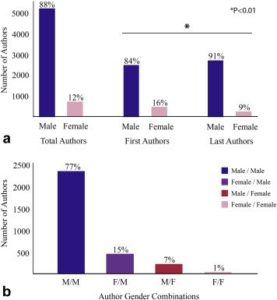
Women are equally as productive as men in terms of number of publications, citations, and grants, a recent study investigating the impact of women in academic interventional radiology (IR) concludes. The study, published in the Journal of Vascular and Interventional Radiology, found that women are also proportionately represented in the literature, and that female authorship is in fact increasing.
The study investigators, Nicholas Xiao (Department of Radiology, Section of Interventional and Vascular Radiology, Northwestern University, Chicago, USA), Diego Oliveira (Department of Chemical and Biological Engineering, Northwestern University, Chicago, USA), and Ramona Gupta (Department of Radiology, Section of Interventional and Vascular Radiology, Northwestern University, Chicago, USA) set out to determine the representation of female IRs, and to elucidate possible gender-specific disparities.
They analysed 4,884 original, peer-reviewed articles from 2006–2017 in the Journal of Vascular and Interventional Radiology and Cardiovascular and Interventional Radiology. The first author and the senior author were then the subjects of scrutiny to assess gender, citations and grants.
Xiao and colleagues write: “We found that 84% of first authors and 91.4% of senior authors were male (P<0.01)”. Additionally, there was no significant difference in author gender collaboration combinations (P=1).
The study also reported an increasing number of articles authored by women within the 11-year time-frame. Each year, there was a 0.3–0.4% increase in the number of articles with a female first author (P=0.05) or senior author (P=0.01). Furthermore, citations and grants received by female authors increased each year.
The lack of data indicating collaborative or citation/ grant discrimination prompt Xiao, Oliveira and Gupta to believe that “the academic IR community is inclusive of its female constituents, and equally respects their research contributions.”
They conclude: “Based on the statistically significant increases in female authorship observed in this 12-year study, this article reports encouraging trends for the future of women in interventional radiology.”

Speaking to Interventional News, Xiao explains that he and his co-authors were not expecting this result. He says: “There are recent papers published in other academic disciplines showing significant bias against female authors in the literature, especially in highly male predominant fields. While we were certainly not expecting IR to reproduce this discrimination, we were pleased to discover that the data did not suggest any type of gender bias, despite IR being one of the most gender imbalanced fields in medicine. I was surprised at the high percentage of women as first authors as compared to the percentage of women in the field. As first authors are frequently the team members whom really drive the project forward, and are often junior to the senior author, this finding, to me, meant that more and more women are entering IR and contributing productively to the literature! This was further supported by trends showing a steady increase of women in the field.”
Research from December 2016, conducted by Mikhail Higgins (Division of Vascular and Interventional Radiology, Department of Radiology, University of Virginia, Virginia, USA) et al and published in the same journal, found that women and minority ethnicities were underrepresented in the IR academic physician workforce relative to the US population. Similar conclusions from other studies, coupled with personal experiences of female IRs, has led to an increased acknowledgement in recent years of gender disparities in healthcare, leading to campaigns advocating for greater equality, such as #ThisIsWhatASurgeonLooksLike on Twitter.
Xiao highlights the importance of social media as a way to promote inclusivity within IR, saying, “I personally follow a number of prominent interventionalists on Twitter, and they are vocal advocates for all minorities in IR and actively engage in mentorship. I believe that the aforementioned candid recognition that biases (gender or otherwise) exist and vocal leadership calling attention to these issues causes a trickle down/ compounding effect and fosters a culture of inclusion.”
Amongst the backdrop of underrepresentation within the field, this recent research demonstrates that in this particular academic context, gender disparity does not come into play.
Delineating why this finding is important, Xiao comments, “I hope that it is encouraging to all women in the field, especially medical students considering the field and young trainees conducting research or pursuing academic careers. While it certainly does not fix the gender gap in IR, I hope that it at least shows that women in the field are respected by their male IR colleagues, and that they can be judged by their merits and not be negatively impacted by their gender in this regard. While there are a number of factors that influence the low number of females in the field, this data should be encouraging to those who have reservations about entering the field or pursuing an academic career due to gender biases in publication.”













